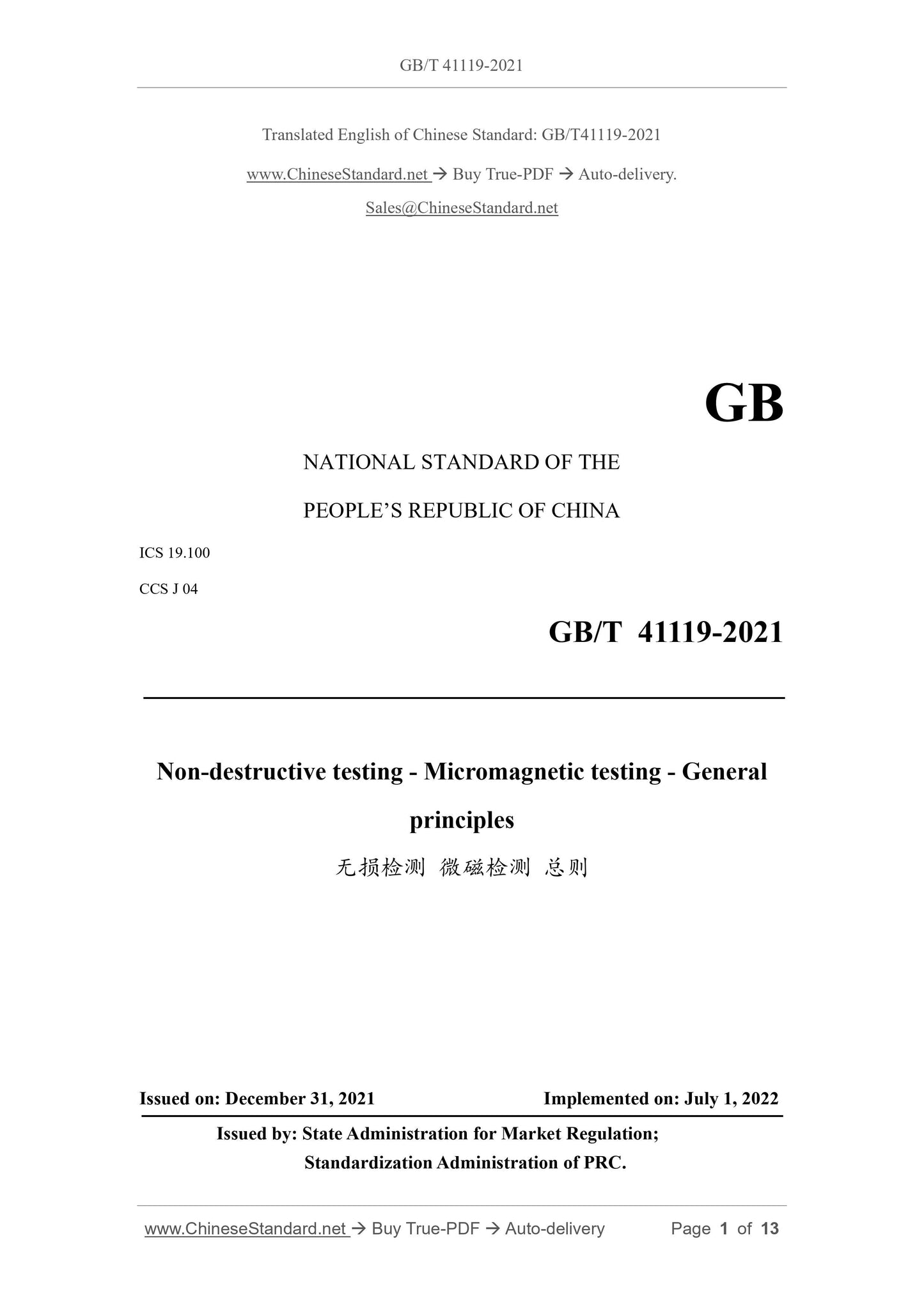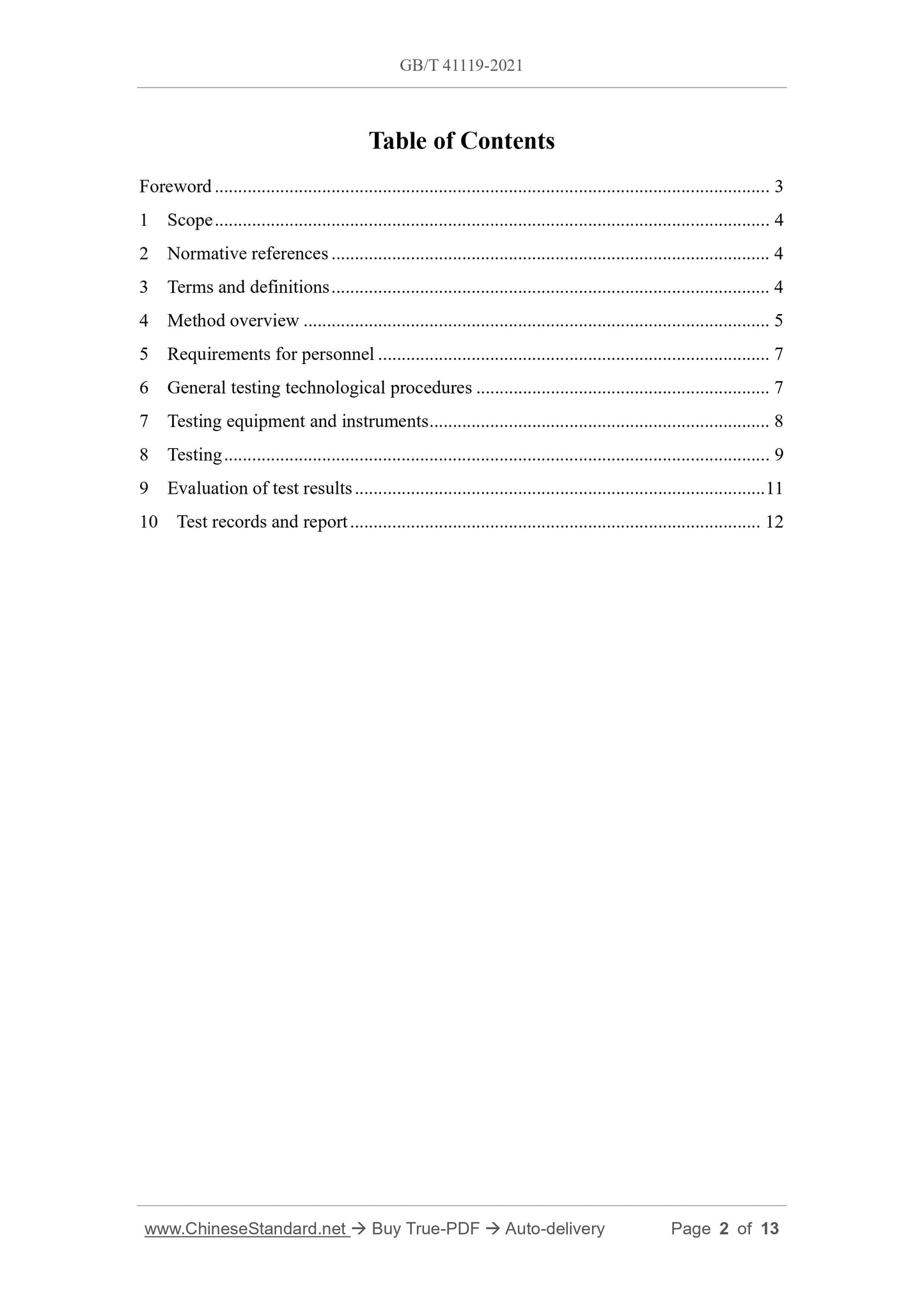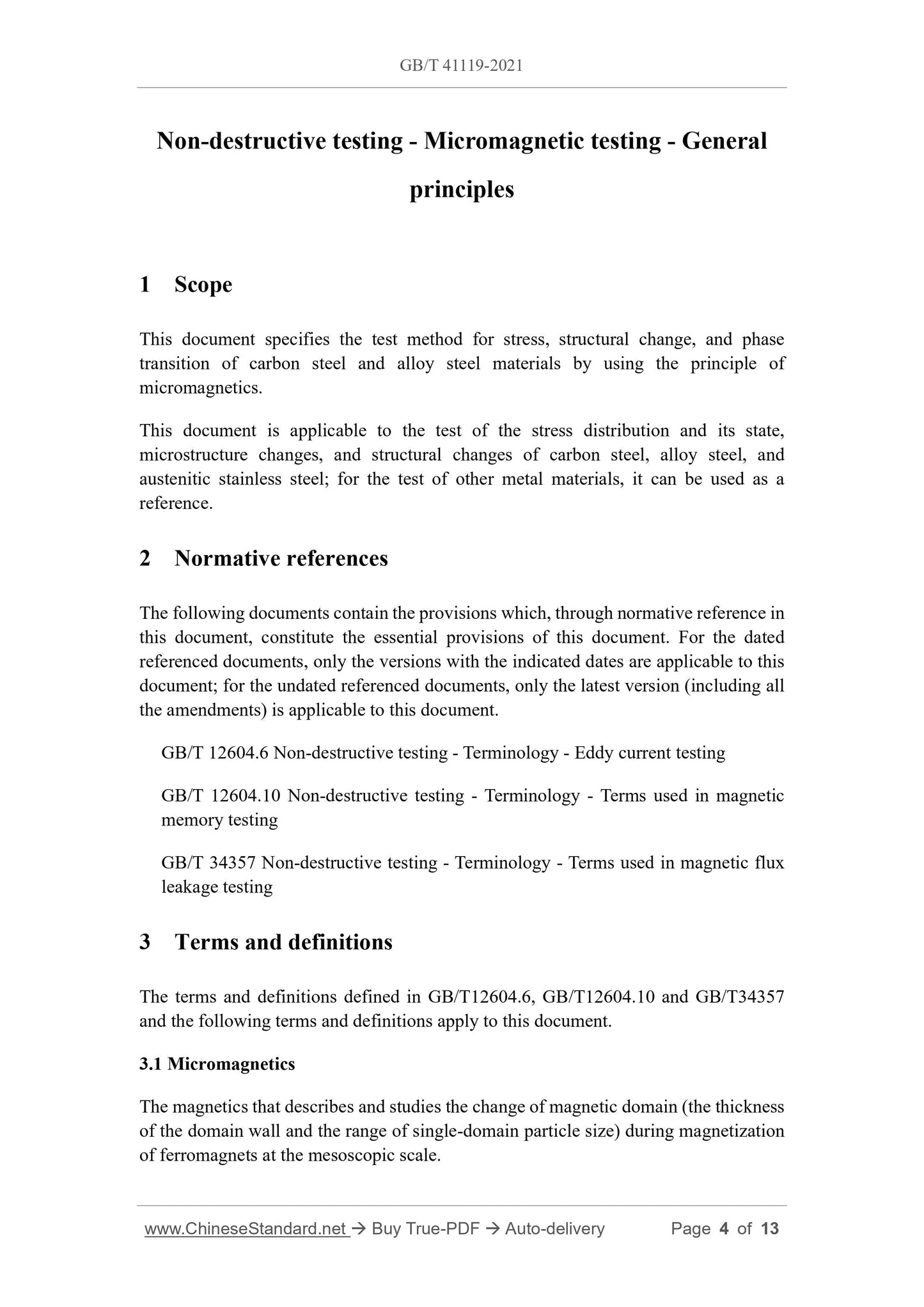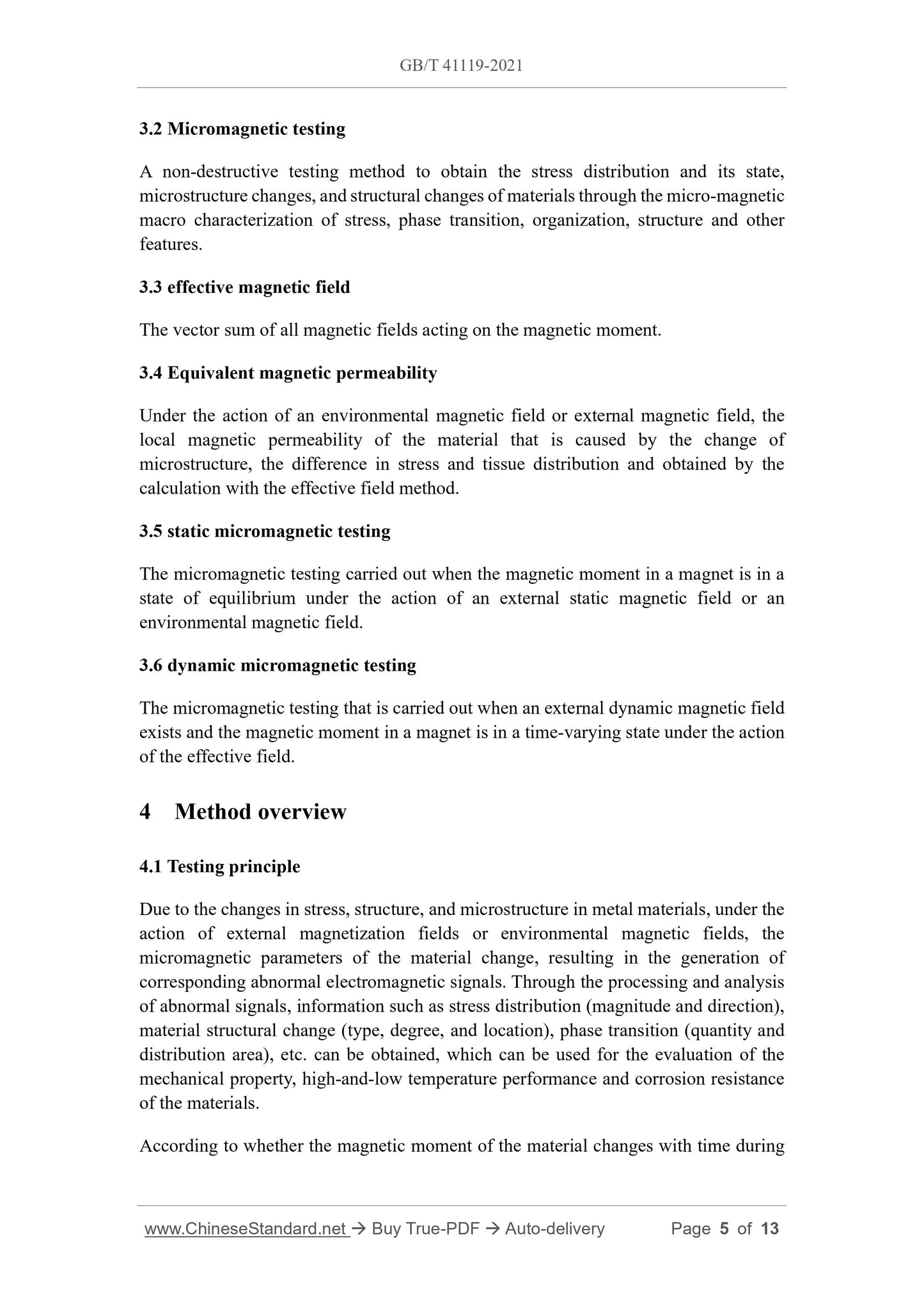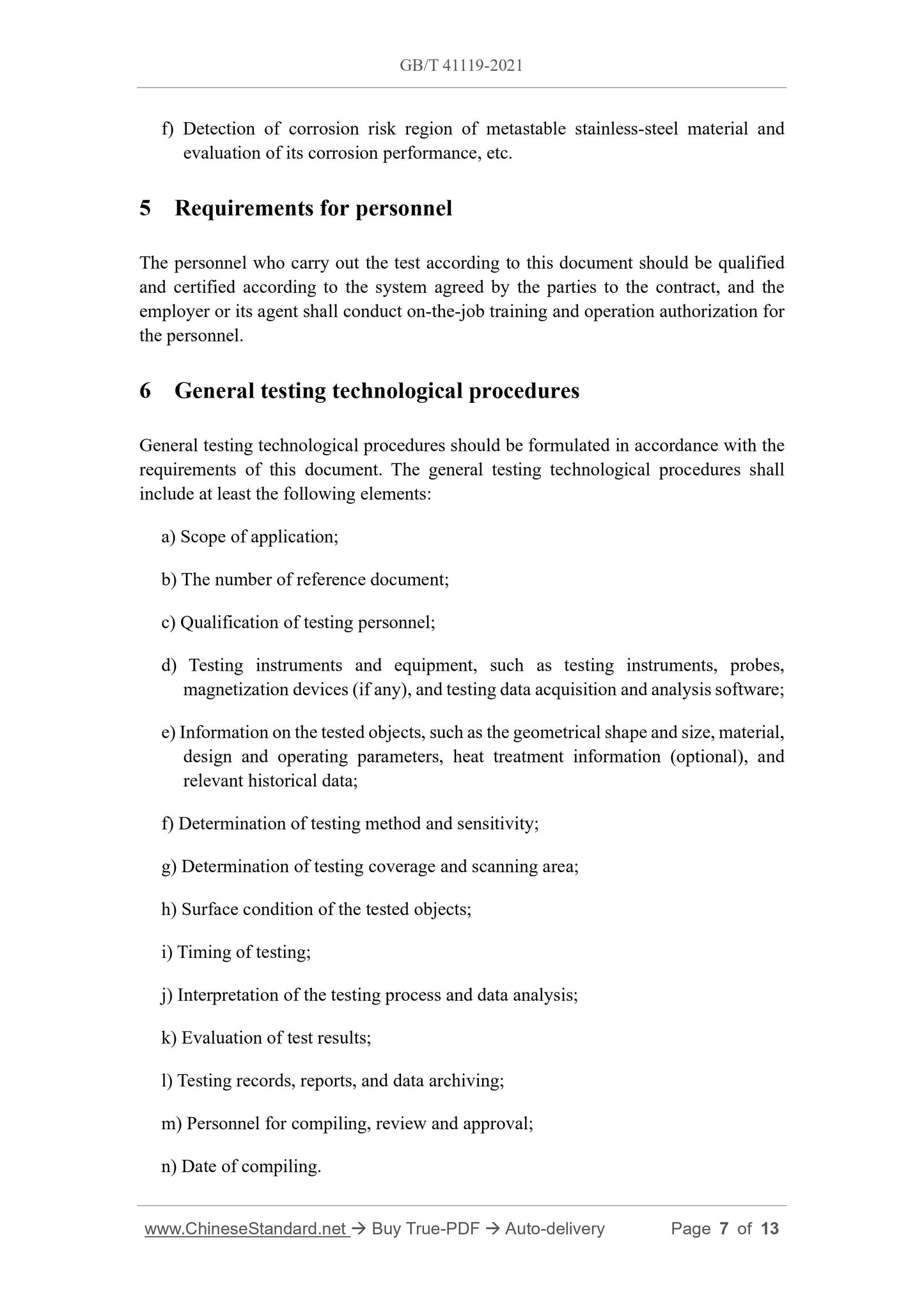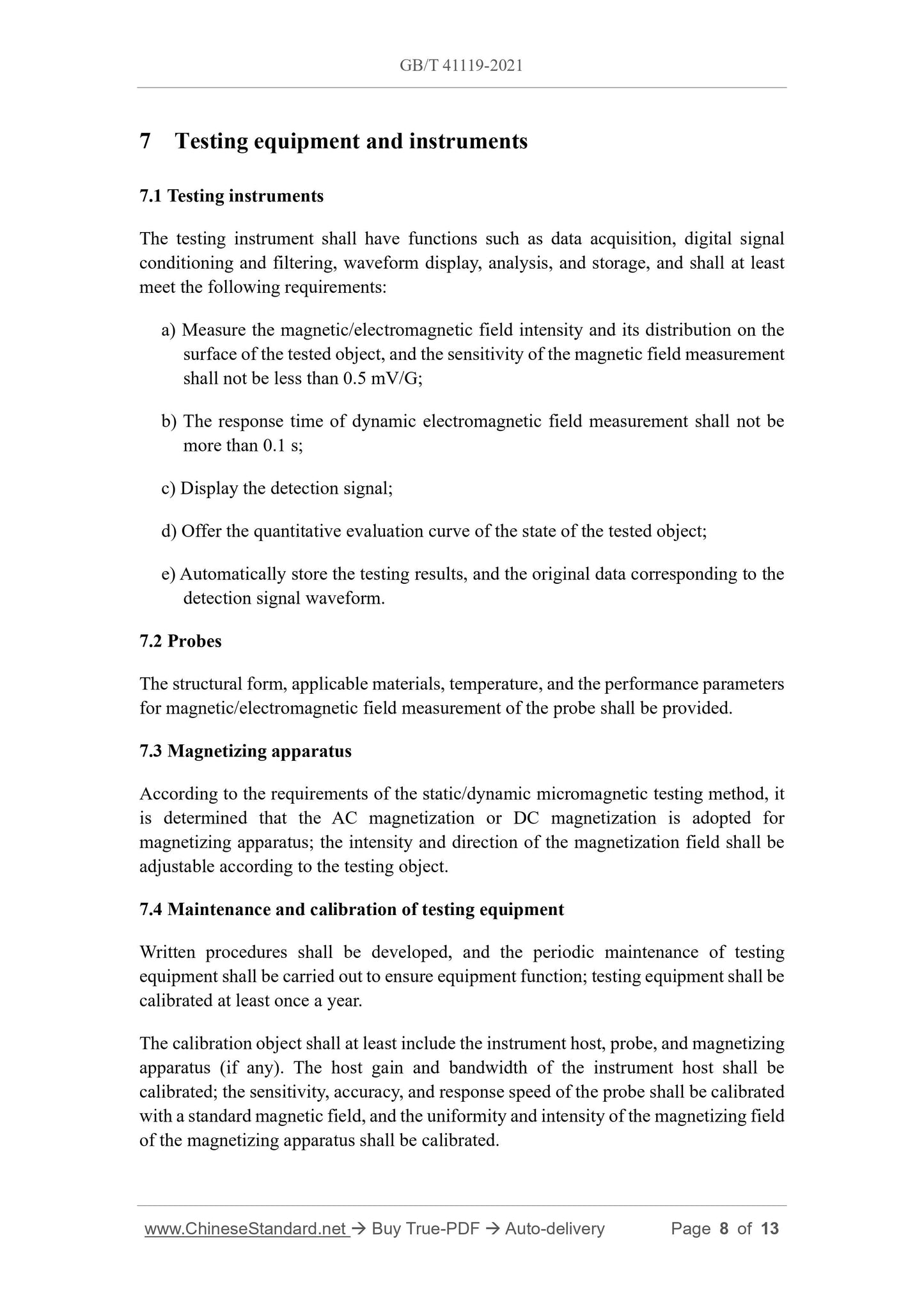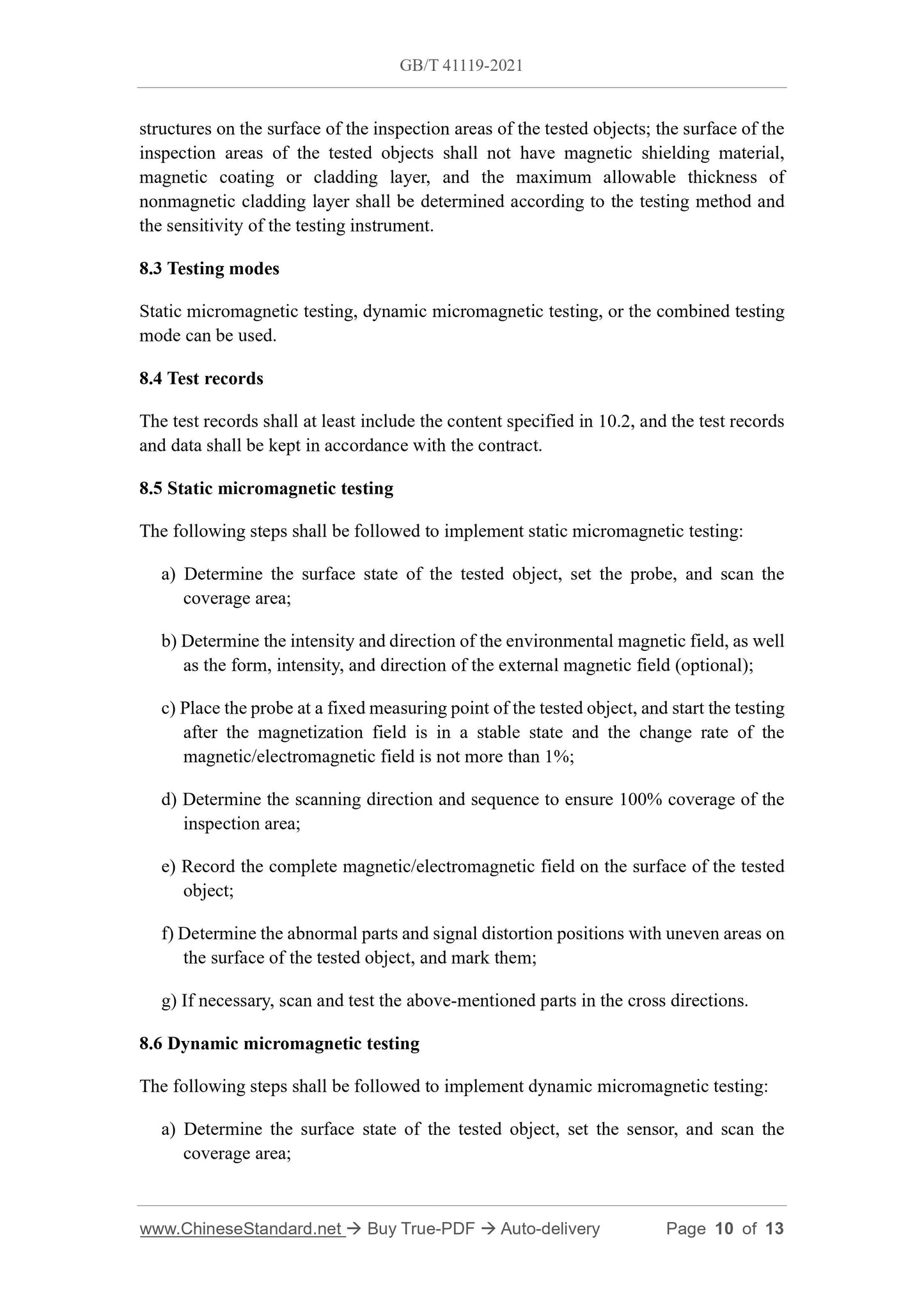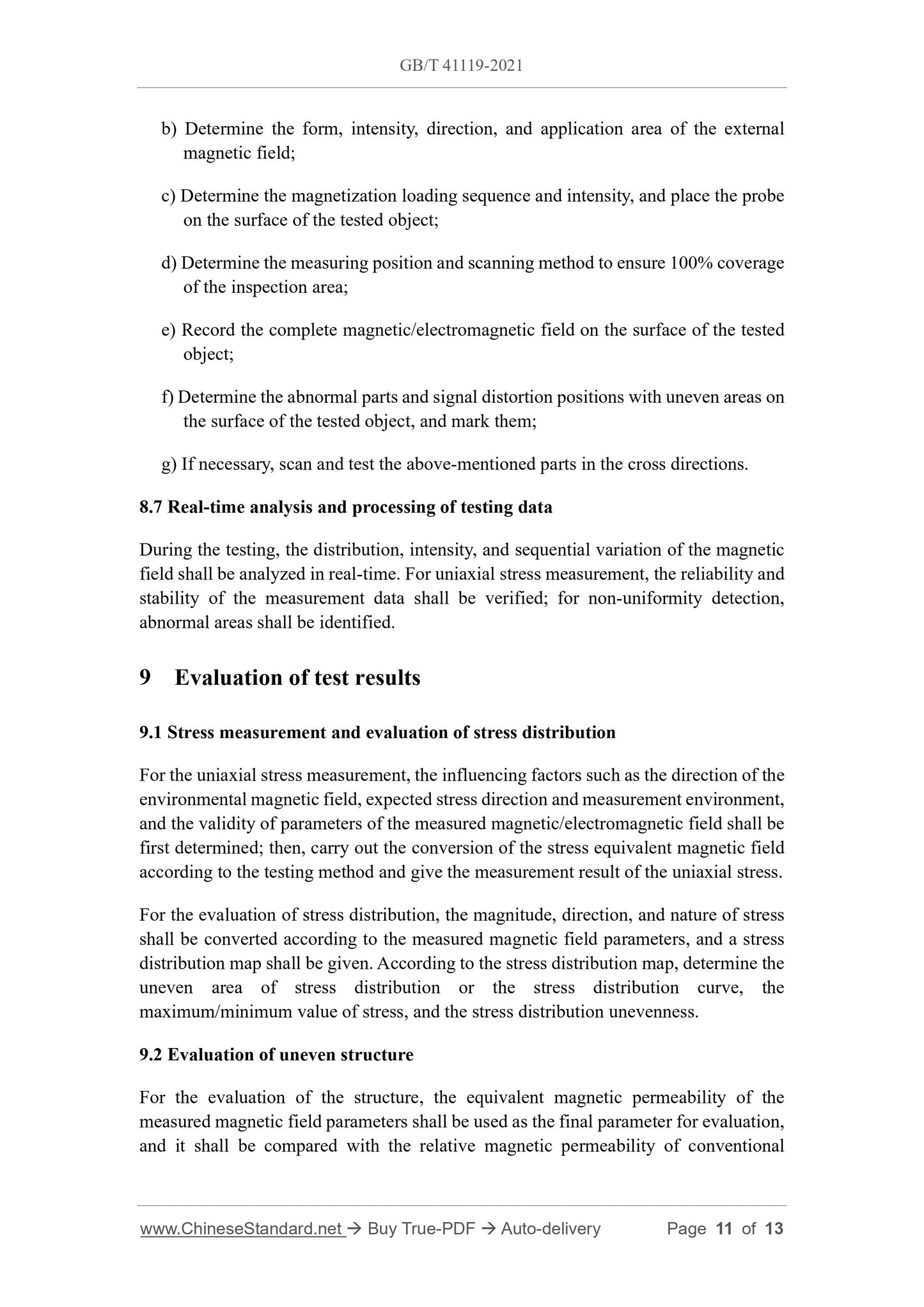1
/
of
8
PayPal, credit cards. Download editable-PDF & invoice in 1 second!
GB/T 41119-2021 English PDF (GBT41119-2021)
GB/T 41119-2021 English PDF (GBT41119-2021)
Regular price
$170.00 USD
Regular price
Sale price
$170.00 USD
Unit price
/
per
Shipping calculated at checkout.
Couldn't load pickup availability
Delivery: 3 seconds. Download true-PDF + Invoice.
Get QUOTATION in 1-minute: Click GB/T 41119-2021
Historical versions: GB/T 41119-2021
Preview True-PDF (Reload/Scroll if blank)
GB/T 41119-2021: Non-destructive testing -- Micromagnetic testing -- General principles
GB/T 41119-2021
NATIONAL STANDARD OF THE
PEOPLE’S REPUBLIC OF CHINA
ICS 19.100
CCS J 04
Non-destructive testing - Micromagnetic testing - General
principles
ISSUED ON: DECEMBER 31, 2021
IMPLEMENTED ON: JULY 1, 2022
Issued by: State Administration for Market Regulation;
Standardization Administration of PRC.
Table of Contents
Foreword ... 3
1 Scope ... 4
2 Normative references ... 4
3 Terms and definitions ... 4
4 Method overview ... 5
5 Requirements for personnel ... 7
6 General testing technological procedures ... 7
7 Testing equipment and instruments ... 8
8 Testing ... 9
9 Evaluation of test results ... 11
10 Test records and report ... 12
Non-destructive testing - Micromagnetic testing - General
principles
1 Scope
This document specifies the test method for stress, structural change, and phase
transition of carbon steel and alloy steel materials by using the principle of
micromagnetics.
This document is applicable to the test of the stress distribution and its state,
microstructure changes, and structural changes of carbon steel, alloy steel, and
austenitic stainless steel; for the test of other metal materials, it can be used as a
reference.
2 Normative references
The following documents contain the provisions which, through normative reference in
this document, constitute the essential provisions of this document. For the dated
referenced documents, only the versions with the indicated dates are applicable to this
document; for the undated referenced documents, only the latest version (including all
the amendments) is applicable to this document.
GB/T 12604.6 Non-destructive testing - Terminology - Eddy current testing
GB/T 12604.10 Non-destructive testing - Terminology - Terms used in magnetic
memory testing
GB/T 34357 Non-destructive testing - Terminology - Terms used in magnetic flux
leakage testing
3 Terms and definitions
The terms and definitions defined in GB/T12604.6, GB/T12604.10 and GB/T34357
and the following terms and definitions apply to this document.
3.1 Micromagnetics
The magnetics that describes and studies the change of magnetic domain (the thickness
of the domain wall and the range of single-domain particle size) during magnetization
of ferromagnets at the mesoscopic scale.
3.2 Micromagnetic testing
A non-destructive testing method to obtain the stress distribution and its state,
microstructure changes, and structural changes of materials through the micro-magnetic
macro characterization of stress, phase transition, organization, structure and other
features.
3.3 effective magnetic field
The vector sum of all magnetic fields acting on the magnetic moment.
3.4 Equivalent magnetic permeability
Under the action of an environmental magnetic field or external magnetic field, the
local magnetic permeability of the material that is caused by the change of
microstructure, the difference in stress and tissue distribution and obtained by the
calculation with the effective field method.
3.5 static micromagnetic testing
The micromagnetic testing carried out when the magnetic moment in a magnet is in a
state of equilibrium under the action of an external static magnetic field or an
environmental magnetic field.
3.6 dynamic micromagnetic testing
The micromagnetic testing that is carried out when an external dynamic magnetic field
exists and the magnetic moment in a magnet is in a time-varying state under the action
of the effective field.
4 Method overview
4.1 Testing principle
Due to the changes in stress, structure, and microstructure in metal materials, under the
action of external magnetization fields or environmental magnetic fields, the
micromagnetic parameters of the material change, resulting in the generation of
corresponding abnormal electromagnetic signals. Through the processing and analysis
of abnormal signals, information such as stress distribution (magnitude and direction),
material structural change (type, degree, and location), phase transition (quantity and
distribution area), etc. can be obtained, which can be used for the evaluation of the
mechanical property, high-and-low temperature performance and corrosion resistance
of the materials.
According to whether the magnetic moment of the material changes with time during
f) Detection of corrosion risk region of metastable stainless-steel material and
evaluation of its corrosion performance, etc.
5 Requirements for personnel
The personnel who carry out the test according to this document should be qualified
and certified according to the system agreed by the parties to the contract, and the
employer or its agent shall conduct on-the-job training and operation authorization for
the personnel.
6 General testing technological procedures
General testing technological procedures should be formulated in accordance with the
requirements of this document. The general testing technological procedures shall
include at least the following elements:
a) Scope of application;
b) The number of reference document;
c) Qualification of testing personnel;
d) Testing instruments and equipment, such as testing instruments, probes,
magnetization devices (if any), and testing data acquisition and analysis software;
e) Information on the tested objects, such as the geometrical shape and size, material,
design and operating parameters, heat treatment information (optional), and
relevant historical data;
f) Determination of testing method and sensitivity;
g) Determination of testing coverage and scanning area;
h) Surface condition of the tested objects;
i) Timing of testing;
j) Interpretation of the testing process and data analysis;
k) Evaluation of test results;
l) Testing records, reports, and data archiving;
m) Personnel for compiling, review and approval;
n) Date of compiling.
7 Testing equipment and instruments
7.1 Testing instruments
The testing instrument shall have functions such as data acquisition, digital signal
conditioning and filtering, waveform display, analysis, and storage, and shall at least
meet the following requirements:
a) Measure the magnetic/electromagnetic field intensity and its distribution on the
surface of the tested object, and the sensitivity of the magnetic field measurement
shall not be less than 0.5 mV/G;
b) The response time of dynamic electromagnetic field measurement shall not be
more than 0.1 s;
c) Display the detection signal;
d) Offer the quantitative evaluation curve of the state of the tested object;
e) Automatically store the testing results, and the original data corresponding to the
detection signal waveform.
7.2 Probes
The structural form, applicable materials, temperature, and the performance parameters
for magnetic/electromagnetic field measurement of the probe shall be provided.
7.3 Magnetizing apparatus
According to the requirements of the static/dynamic micromagnetic testing method, it
is determined that the AC magnetization or DC magnetization is adopted for
magnetizing apparatus; the intensity and direction of the magnetization field shall be
adjustable according to the testing object.
7.4 Maintenance and calibration of testing equipment
Written procedures shall be developed, and the periodic maintenance of testing
equipment shall be carried out to ensure equipment function; testing equipment shall be
calibrated at least once a year.
The calibration object shall at least ...
Get QUOTATION in 1-minute: Click GB/T 41119-2021
Historical versions: GB/T 41119-2021
Preview True-PDF (Reload/Scroll if blank)
GB/T 41119-2021: Non-destructive testing -- Micromagnetic testing -- General principles
GB/T 41119-2021
NATIONAL STANDARD OF THE
PEOPLE’S REPUBLIC OF CHINA
ICS 19.100
CCS J 04
Non-destructive testing - Micromagnetic testing - General
principles
ISSUED ON: DECEMBER 31, 2021
IMPLEMENTED ON: JULY 1, 2022
Issued by: State Administration for Market Regulation;
Standardization Administration of PRC.
Table of Contents
Foreword ... 3
1 Scope ... 4
2 Normative references ... 4
3 Terms and definitions ... 4
4 Method overview ... 5
5 Requirements for personnel ... 7
6 General testing technological procedures ... 7
7 Testing equipment and instruments ... 8
8 Testing ... 9
9 Evaluation of test results ... 11
10 Test records and report ... 12
Non-destructive testing - Micromagnetic testing - General
principles
1 Scope
This document specifies the test method for stress, structural change, and phase
transition of carbon steel and alloy steel materials by using the principle of
micromagnetics.
This document is applicable to the test of the stress distribution and its state,
microstructure changes, and structural changes of carbon steel, alloy steel, and
austenitic stainless steel; for the test of other metal materials, it can be used as a
reference.
2 Normative references
The following documents contain the provisions which, through normative reference in
this document, constitute the essential provisions of this document. For the dated
referenced documents, only the versions with the indicated dates are applicable to this
document; for the undated referenced documents, only the latest version (including all
the amendments) is applicable to this document.
GB/T 12604.6 Non-destructive testing - Terminology - Eddy current testing
GB/T 12604.10 Non-destructive testing - Terminology - Terms used in magnetic
memory testing
GB/T 34357 Non-destructive testing - Terminology - Terms used in magnetic flux
leakage testing
3 Terms and definitions
The terms and definitions defined in GB/T12604.6, GB/T12604.10 and GB/T34357
and the following terms and definitions apply to this document.
3.1 Micromagnetics
The magnetics that describes and studies the change of magnetic domain (the thickness
of the domain wall and the range of single-domain particle size) during magnetization
of ferromagnets at the mesoscopic scale.
3.2 Micromagnetic testing
A non-destructive testing method to obtain the stress distribution and its state,
microstructure changes, and structural changes of materials through the micro-magnetic
macro characterization of stress, phase transition, organization, structure and other
features.
3.3 effective magnetic field
The vector sum of all magnetic fields acting on the magnetic moment.
3.4 Equivalent magnetic permeability
Under the action of an environmental magnetic field or external magnetic field, the
local magnetic permeability of the material that is caused by the change of
microstructure, the difference in stress and tissue distribution and obtained by the
calculation with the effective field method.
3.5 static micromagnetic testing
The micromagnetic testing carried out when the magnetic moment in a magnet is in a
state of equilibrium under the action of an external static magnetic field or an
environmental magnetic field.
3.6 dynamic micromagnetic testing
The micromagnetic testing that is carried out when an external dynamic magnetic field
exists and the magnetic moment in a magnet is in a time-varying state under the action
of the effective field.
4 Method overview
4.1 Testing principle
Due to the changes in stress, structure, and microstructure in metal materials, under the
action of external magnetization fields or environmental magnetic fields, the
micromagnetic parameters of the material change, resulting in the generation of
corresponding abnormal electromagnetic signals. Through the processing and analysis
of abnormal signals, information such as stress distribution (magnitude and direction),
material structural change (type, degree, and location), phase transition (quantity and
distribution area), etc. can be obtained, which can be used for the evaluation of the
mechanical property, high-and-low temperature performance and corrosion resistance
of the materials.
According to whether the magnetic moment of the material changes with time during
f) Detection of corrosion risk region of metastable stainless-steel material and
evaluation of its corrosion performance, etc.
5 Requirements for personnel
The personnel who carry out the test according to this document should be qualified
and certified according to the system agreed by the parties to the contract, and the
employer or its agent shall conduct on-the-job training and operation authorization for
the personnel.
6 General testing technological procedures
General testing technological procedures should be formulated in accordance with the
requirements of this document. The general testing technological procedures shall
include at least the following elements:
a) Scope of application;
b) The number of reference document;
c) Qualification of testing personnel;
d) Testing instruments and equipment, such as testing instruments, probes,
magnetization devices (if any), and testing data acquisition and analysis software;
e) Information on the tested objects, such as the geometrical shape and size, material,
design and operating parameters, heat treatment information (optional), and
relevant historical data;
f) Determination of testing method and sensitivity;
g) Determination of testing coverage and scanning area;
h) Surface condition of the tested objects;
i) Timing of testing;
j) Interpretation of the testing process and data analysis;
k) Evaluation of test results;
l) Testing records, reports, and data archiving;
m) Personnel for compiling, review and approval;
n) Date of compiling.
7 Testing equipment and instruments
7.1 Testing instruments
The testing instrument shall have functions such as data acquisition, digital signal
conditioning and filtering, waveform display, analysis, and storage, and shall at least
meet the following requirements:
a) Measure the magnetic/electromagnetic field intensity and its distribution on the
surface of the tested object, and the sensitivity of the magnetic field measurement
shall not be less than 0.5 mV/G;
b) The response time of dynamic electromagnetic field measurement shall not be
more than 0.1 s;
c) Display the detection signal;
d) Offer the quantitative evaluation curve of the state of the tested object;
e) Automatically store the testing results, and the original data corresponding to the
detection signal waveform.
7.2 Probes
The structural form, applicable materials, temperature, and the performance parameters
for magnetic/electromagnetic field measurement of the probe shall be provided.
7.3 Magnetizing apparatus
According to the requirements of the static/dynamic micromagnetic testing method, it
is determined that the AC magnetization or DC magnetization is adopted for
magnetizing apparatus; the intensity and direction of the magnetization field shall be
adjustable according to the testing object.
7.4 Maintenance and calibration of testing equipment
Written procedures shall be developed, and the periodic maintenance of testing
equipment shall be carried out to ensure equipment function; testing equipment shall be
calibrated at least once a year.
The calibration object shall at least ...
Share
